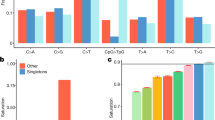Summary
A total of 50 different ACTBP2 (human betaactin related pseudogene) alleles and the cell line K562 were sequenced and analysed. Sequence data revealed not only length polymorphism but also a highly variable sequence polymorphism. 2 different sequence structures were characterised. Type I (223–259bp) contained the known regular 4bp repeat AAAG. Type II (265–309 bp) revealed a further hexanucleotide unit AAAAAG in addition to the common AAAG which only occurs once in the repeat region. The position of this insertion showed considerable variation. To obtain a regular spaced allelic ladder 20 of the sequenced alleles were selected. Denaturing gels and high resolution/non-denaturing gels were compared and striking differences could be seen between the 2 gel systems. Separation of the alleles on a 6% denaturing gel and analysis on the ABI 373A Sequencer revealed fragment sizes which corresponded to the sequencing data but were in general 6–10bp longer. In contrast, in non-denaturing gels some alleles showed different electrophoretic mobilities compared to the sequenced allelic ladder which could indicate different fragment length and/or different sequence structure.
Zusammenfassung
50 verschiedene ACTBP2 Allele und die Zell-Linie K562 wurden sequenziert und analysiert. Die Sequenzierergebnisse zeigen nicht nur einen Längensondern auch einen hoch variablen Sequenzpolymorphismus. 2 verschiedene Sequenzstrukturen wurden charakterisiert. Typ 1 (223–259bp) enthält den regulären 4bp-Repeat AAAG. Im Typ II (265–309 bp) tritt zusätzlich die Hexanukleotideinheit AAAAAG auf, deren Position innerhalb der Repeatregion stark variabel ist. 20 sequenzierte Allele wurden für die Konstruktion einer allelischen Leiter ausgewählt. Denaturierende und hochauflösende, nicht denaturierende Gele wurden ausgewertet und Unterschiede im Wanderungsverhalten der Allele festgestellt. In denaturierenden Gelen ist die elektrische Mobilität abhängig von den Fragmentlängen der Allele. Dagegen zeigen in nicht denaturierenden Gelen einige Allele unterschiedliches Wanderungsverhalten im Vergleich zur sequenzierten allelischen Leiter, welches durch unterschiedliche Fragmentlängen und/oder unterschiedliche Sequenzstrukturen erklärt werden kann.
Similar content being viewed by others
References
Adams M, Urquhart A, Kimpton C, Gill P (1993) The human D11S554 locus: four distinct families of repeat pattern alleles at one locus. Hum Mol Genet 2:1373–1376
Brinkmann B (1992) The use of STRs in stain analysis. In: Proceedings from the Third International Symposium on Human Identification. Promega Corporation, Madison, USA, pp 357–373
Brinkmann B, Rand S, Wiegand P (1991) Population and family data of RFLP's using selected single- and multi-locus systems. Int J Leg Med 104:81–86
Budowle B, Chakraborty R, Giusti AM, Eisenberg AJ, Allen RC (1991) Analysis of the variable number of tandem repeat locus D1S80 by the polymerase chain reaction followed by high resolution polyacrylamide gel electrophoresis. Am J Hum Genet 48:137–144
Edwards A, Hammond HA, Jin L, Caskey CT, Chakraborty R (1992) Genetic variation at five trimeric and tetrameric tandem repeat loci in four human population groups. Genomics 12:241–253
Grossman LI (1989) Gel electrophoresis of DNA. In: Proceedings of the International Symposium on the Forensic Aspects of DNA Analysis. FBI Academy, Quantico (Virginia), pp 37–46
Hagerman PJ (1985) Sequence dependence of the Curvature of DNA: A Test of the Phasing Hypothesis. Biochem 24:7033–7037
Kimpton CP, Walton A, Gill P (1992) A further tertanucleotide repeat polymorphism in the vWF gene. Hum Mol Genet 1:28
Kimpton CP, Gill P, Walton A, Urquhart A, Millican ES, Adams M (1993) Automated DNA profiling employing multiplex amplification of short tandem repeat loci. PCR Methods Applic 3: 13–22
Maniatis T, Fritsch EF, Sambrook, J (1989) “Molecular cloning: A Laboratory Manual”, Cold Spring Harbour Laboratory, Cold Spring Harbor, New York
Marini JC, Levence SD, Crothers DM, Englund PT (1982) Bent helical structure in kinetoplast DNA. Proc Natl Acad Sci USA 79:7664–7668
Mertz JE, Berg P (1974) Viable Deletion Mutants of Simian Virus 40: Selective isolation by means of a Restriction Endonuclease from hemophilus parainfluenzae. Proc Natl Acad Sci USA 71:4879–4883
Moos M, Gallwitz D (1983) Structure of two β-actin-related processed genes one of which is located next to a simple repetitive sequence. EMBO J 2:757–761
Polymeropoulos MH, Xiao H, Merril CR (1992a) Tetranucleotide repeat polymorphism at the human myelin basic protein (MBP). Hum Mol Genet 1:658
Polymeropoulos MH, Rath DS, Xiao H, Merril CR (1992b) Tetranucleotide repeat polymorphism at the human beta-actin related pseudogene H-beta-Ac-psi-2 (ACTBP2). Nucleic Acids Res 20:1432
Puers C, Hammond HA, Jin L, Caskey T, Schumm JW (1993) Identification of repeat sequence heterogeneity at the polymorphic short tandem repeat locus HumTH01(AATG) and reassignment of alleles in population analysis by using a locus-specific allelic ladder. Am J Hum Genet 53:953–958
Sullivan KM, Pope P, Gill P, Robertson JM (1992) Automated DNA profiling by fluorescent labeling of PCR products. PCR Methods Applic 2:34–40
Wiegand P, Budowle B, Rand S, Brinkmann B (1993) Forensic validation of the STR systems SE33 and TC11. Int J Leg Med 105:315–320
Urquhart A, Kimpton CP, Gill P (1993) Sequence variability of the tetranucleotide repeat of the human beta-actin related pseudogene H-beta-Ac-psi-2 (ACTBP2) locus. Hum Genet 92:637–638
Author information
Authors and Affiliations
Rights and permissions
About this article
Cite this article
Möller, A., Brinkmann, B. Locus ACTBP2 (SE33). Int J Leg Med 106, 262–267 (1994). https://doi.org/10.1007/BF01225417
Received:
Issue Date:
DOI: https://doi.org/10.1007/BF01225417




